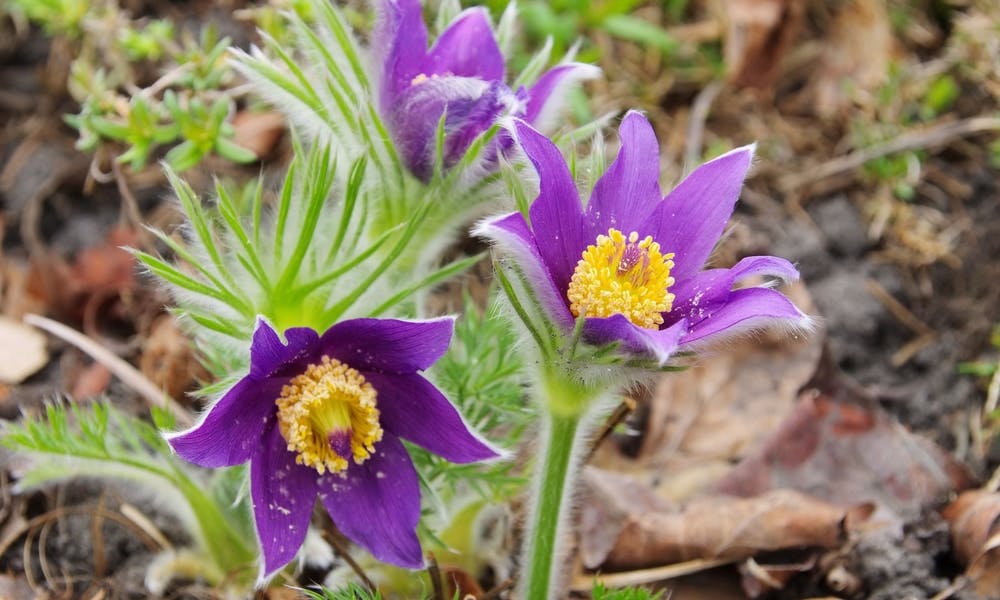MENU
The Pasque Flower

From bloody roman battlefields to gorgeous meadows blooming with its lavender bell-shaped sepals, the pasque flower has a storied history among the countries of Europe and North America. Belonging to the buttercup family, it is one of nature’s most easily distinguishable flowers. It can be found blooming for only two weeks during the spring season, so having the chance to see it blossom is a gift indeed. Tune in as we explore all there is to know, from old legends to tips and tricks for growing and caring for your own.
Keep on reading to find out the:
- History of the Pasque Flower
- Pasque Flower Details
- Symbolism in Culture
- Traditional Use in Medicine
- How to Grow Your Own
- Care and Pruning
History of the Pasque Flower
Known as the pulsatilla in scientific circles, the genus contains close to 40 species. It is sometimes considered part of the anemone genus as well. The pasque flower is an herbaceous flowering plant and is native to Europe, parts of Asia, as well as North America. It is typically found in regions with prairies and meadows and can be found on rocky slopes and outcroppings also. The flower tends to grow best in the tundra. Most of the species are perennial plants and can last for several years. Other names have been ascribed to the flower, such as windflower, meadow anemone, and prairie crocus. It is the state flower of South Dakota, as well as the provincial flower of the province of Manitoba, Canada. Within the U.K the pasque flower has become a protected species, with attempts at re-introduction being instituted as the species has declined 50 percent.
Pasque Flower Details
The pasque flower can grow anywhere from 15 to 40 cm in height. It has whorl shaped flowers, which resemble a slightly upturned bell, with each part made up of sepals. There are generally five to eight sepals per leaf. The leaves are very thin and dissected. It has a long stem, somewhat hairy and with a unique silver-grey color. The roots tend to go a meter or so deep. It bears a few seeds with a silk-like texture. The stamen is a bright yellow, with the sepals being a lovely, vivid purple, although a few species have a pale, white color. Once they have shed their sepals after blooming season, the flowers become somewhat elongated, with plumose leaves. It produces abundant amounts of pollen, and is commonly pollinated by bees, although a few other insect species take part in pollination as well.
Symbolism in Culture
Symbolism abounds within the world of flowers, and the pasque flower has its share. There is an ancient legend that says that the pasque blooms only in places where the blood of Roman and Dane warriors has soaked deep into the soil. In Christian symbology, the pasque flower is associated with ideas of rebirth, dignity, nobility, and grace. It relates to the Easter holiday, and its purple pigmentation was used in olden times to color and stain Easter eggs. Its name, pasquilla, stems from the Hebrew word for Easter, “pasakh.” In old native American tradition, the pasque flower was sung of in songs. Within the Rocky Mountain regions, the natives considered it to be one of four sacred plants. In Greek mythology, it is said that the flower came into being after Aphrodite, goddess of love, learnt of her partners death, and her tears became the pasque.
Traditional Use in Medicine
Although quite toxic when fresh, the pasque flower has been shown to have some medicinal properties in studies, as well as having been used traditionally for quite some time. It has been used in Europe for treatment of asthma, dysmenorrhea, skin diseases, and even infections of the eye. It has some diuretic properties as well. Many homeopathic remedies utilize parts of the pasque flower, with some touting it as a reliever of insomnia and anxiety. Certain chemicals within the plant have been found to have antiviral, antifungal, and antibacterial effects. Native American tribes were known to use it to induce abortions. Most of the common medicinal uses are done using the dried-out leaves.
How to Grow Your Own
A hardy flower, the pasque requires an area with lots of sunlight to flourish well. If you happen to live in an area with a very dry, and strong sun then a bit of shade for the afternoon is ideal. They do well in humus rich soil that is well-drained. Adding large amounts of compost, as well as some coarse sand while planting is recommended. Transplanting pasque flowers tends to not agree with them as their roots are very fragile, so make sure to choose your planting site carefully so that you do not have to move them. The seeds are quite hardy, so transplanting them is quite an easy process. Grow them indoors during early spring until they germinate, then shift them outdoors.
Care and Pruning
During the initial phase of growth, it is recommended to water the pasque flower heavily. Once they have settled, make sure to prune off any unhealthy flowers. You can gently look at the roots and cut off any that have been infected by mold or mildew. This is recommended mostly during the wintertime. The curve of its sepals reflect sunlight, producing a warm area that insects come and bask in, so do not be surprised if after planting you end up with larger amounts of insects gathering around your garden.
The Lovely Pasque Flower
With all the difficulties some countries are having keeping the pasque flower populations high, seeding and growing your own is a great idea. With its lovely, deep purple blooms and ease of care, the pasque flower can be a great addition to any garden or the windowsill of any home. Brighten up your spring season with its beauty!

